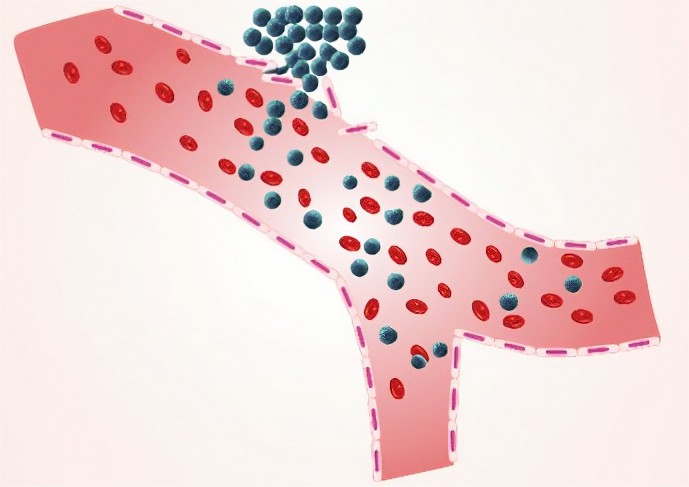With the social and economic burden of lung diseases and medications on the rise, lung-on-a-chip model becomes a booming platform for identifying new and possible best therapeutics for individuals apart from an improvement of the health status of the patient. Creative Biolabs' lung-on-a-chip model is a micro-engineered cell culture device that replicates the 3D microarchitecture and microenvironment, breathing movements as well as primary physiological functions of the human lung. Our model will help you in investigating the physiology and disease etiology of human lungs, toxicological studies, and drug screening.
Creative Biolabs' Lung-on-a-chip Model
By using microfabrication to process microstructures of specific shapes on microchips composed of polydimethylsiloxane silicon or other high polymer materials, two upper and lower microfluidic channel structures are formed. The top channel is seeded with alveolar epithelial cells. While oxygen is given to make an air-liquid interface, fabricating the alveolar structure; the down channel includes vascular endothelial cells and is infused with culture medium, forming capillary channels and fluid shears. The middle platform is parted by a porous membrane to duplicate the alveolar septum. Side chambers are located on both sides of the organ chip that are linked to two vacuum pumps. By modifying the pressure of the side chambers, the porous membrane is stretched to imitating breathing movement. After this process, the cells form a functional tissue unit.
 Fig.1. Lung-on-a-chip. (Tan, 2023)
Fig.1. Lung-on-a-chip. (Tan, 2023)
Benefits of the 3D Microfluidic System
|
In vivo
|
In vitro
|
|
Animal
|
Human
|
Two Dimensional Systems
|

|
√ Simple and convenient
√ Cost-effective
√ Easy to monitor changes in cells
√ Easy to measure extracellular flux and intracellular metabolism
|
× Static
× Not relevant physiologically
× Limited quantification
× No cellular heterogeneity
× Large sample required
|
|
Three Dimensional Systems
|
√ More humanized
√ Allows co-culture
√ In vivo like cellular organism
√ CELL-ECM interaction
|
× Not dynamic
× Limited cellular heterogeneity
× Limited quantification
× Large sample required
|
|
Three Dimensional Microfluidic Systems
|
√ Organ-level interaction
√ Highest cellular heterogeneity
√ Physiologically most relevant
√ More quantitative information
|
√ Most reliable result
√ Most accurate result
√ Favorable risk-benefit ratio
|
√ More accurate representation of the in vivo physiology
√ Cells used are exclusively of human origin
√ Higher control of microenvironment
√ Less samples and reagents consumption
√ Cost effective
√ High sensitivity
√ High-throughput assays
√ Better imaging
|
× Complex system
× Experts required
× Non-standardized protocols
|
× Ethical issue
× Expensive
× Tedious
× Genetically and anatomically different
|
× Ethical issue
× Expensive
× Genetic variability
× Requires extensive resources to run and maintain
|
Table 1. The benefits of the 3D microfluidic system. (Shrestha, 2020)
Our Advantages
-
Provide conditions that are more consistent with the physiological cell microenvironment.
-
Performing experiments using less volume of samples, chemicals, and reagents.
-
Portability, high throughput, low cost, and simulation of the in vivo microenvironment.
-
Targeted therapies by providing more precise results and have several benefits over existing conventional methods.
Applications of Lung-on-a-chip Model
-
Supporting a differentiated, mucociliary, bronchiolar epithelium with an underlying lung microvascular endothelium. It can be used to study the complex processes of inflammatory diseases such as Asthma and COPD, and the evaluation of therapeutic responses.
-
Performing a wound healing assay to test the effects of human pulmonary growth factors and the application of physiological cyclic mechanical stretch. Our Model will help a better understanding of complex pathogenesis of image process function.
-
Having great potential to facilitate the discovery of new mechanisms underlying diseases and the development of safer and more efficient drugs for respiratory disorders.
-
Helping a better understanding of the complex pathological processes of different respiratory as well as other chronic diseases by our disease model of lung-on-a-chip involving the surrounding pleura and/or regional lymph nodes.
-
Enabling further study in the effects of smoking, e-cigarettes, environmental pollution, or inhalational drugs on the airway in detail.
-
Different drugs can be tested to focus on the best possible treatment for personalized medicine by using our different Lung-on-a-chip disease models.
-
Decreasing the dependency of the pharmaceutical companies and researchers on the conventional in vitro and animal models which are usually tedious, expensive, and sometimes unreliable.
Why Choose Us?
Creative Biolabs' lung-on-a-chip model provides fast, reliable, and robust in vitro platforms for studies in parts of the respiratory system, i.e., the nasal cavity, pharynx, larynx, trachea, pleura, and surrounding lymph nodes. Our model can bridge the void between disease-drug studies and effective drug identification and foster detailed research of complex processes in vitro. By elucidating the complex pathophysiology of lung diseases as well as accelerating drug development, our lung-on-a-chip model will facilitate you in the study of complex pulmonary diseases, drug development, personalized medicine, and other applications.
In addition to lung-on-a-chip model, you may also be interested in:
Related Services
Recognized as a premier CRO within the field of 3D biology, Creative Biolabs acutely attuned to the latest trends in advanced technology. Our commitment is unwavering to offer an extensive range of organ-on-a-chip models, coupled with credible supporting services as outlined below. Our team of experts stand ready to elevate the course of your preclinical drug discovery initiatives. Whenever you require any form of professional technical support, we invite you to contact us without hesitation.
References
-
Tan, J.; et al. Biomimetic lung-on-a-chip to model virus infection and drug evaluation. European Journal of Pharmaceutical Sciences. 2023, 180: 106329.
-
Shrestha, J.; et al. Lung-on-a-chip: the future of respiratory disease models and pharmacological studies. Crit Rev Biotechnol. 2020, 40(2): 213-230.
Research Model
Related Sections:

 Fig.1. Lung-on-a-chip. (Tan, 2023)
Fig.1. Lung-on-a-chip. (Tan, 2023)




